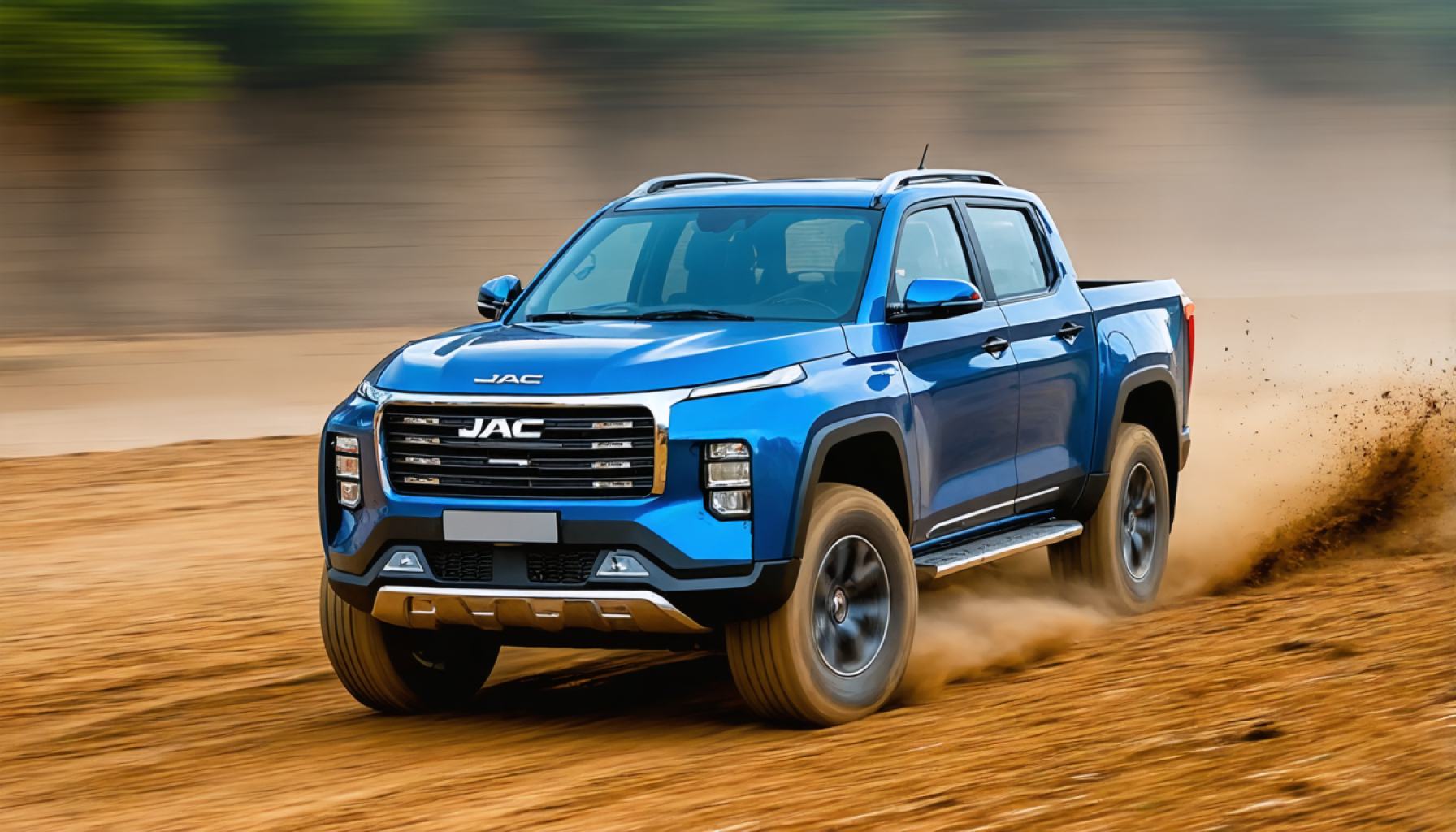- The 2026 JAC Hunter PHEV was unveiled at the Melbourne Motor Show, showcasing immense power and hybrid innovation.
- Features a 385kW output and 1000Nm torque, outperforming competitors like the BYD Shark 6 and GWM Cannon Alpha.
- Equipped with a turbocharged 2.0L engine and lithium-ion phosphate battery for a dual-motor powertrain.
- Offers a 100km battery-only range and the ability to recharge quickly from a wall outlet.
- Designed for robustness with a one-tonne payload and 3500kg towing capacity, enhanced by V2L capabilities.
- Distinctive features include rugged design, advanced infotainment systems, and safety technologies.
- Set for production in late 2025, reaching Australian markets by early 2026.
- Combines environmental responsibility with high performance, epitomizing future automotive innovation.
Beneath the dazzling lights of the Melbourne Motor Show, a new titan was unveiled: the 2026 JAC Hunter PHEV. Like a storm gathering on the horizon, this plug-in hybrid ute promises to reshape the landscape of hybrid utility vehicles with its sheer power and innovation.
At its heart, the JAC Hunter PHEV boasts a monstrous 385kW and a torque-worthy 1000Nm, ensuring it stands head and shoulders above its competition. With a turbocharged 2.0L inline-four engine functioning as a formidable onboard generator paired with a lithium-ion phosphate battery, its dual-motor powertrain suggests it’s less a vehicle and more a force of nature. This stunning combination places it leagues ahead of contenders like the BYD Shark 6 and GWM Cannon Alpha, offering significant increases in power and torque that leave even the wild RAM 1500 TRX in its dust.
As the automotive world holds its breath for 2026, the Hunter PHEV is set to launch amidst the ongoing frenzy over PHEV trucks. Presented as the plug-in hybrid sibling to the diesel-powered JAC T9, this beast is designed not just for raw power but also for environmental responsibility. With an anticipated battery-only range of 100km, owners can enjoy a near-silent glide through the wilderness or the city alike, before the 31.2kWh battery seeks a recharge. Charging from a wall outlet will be a breeze.
Despite being a juggernaut on wheels, the Hunter PHEV doesn’t sacrifice practicality. JAC is targeting a substantial one-tonne payload and a towing capacity of 3500kg, making it perfect for heavy-duty tasks. Moreover, V2L (vehicle-to-load) capabilities transform it into a mobile power station, capable of juicing up everything from tools to camping gear—even keeping the lights on during blackouts.
Externally, the Hunter PHEV retains the rugged charm of the T9, with subtle changes marking its distinctive identity. A unique sail panel, aluminium tie-down rails, striking alloy wheels, and crimson brake calipers set it apart. Inside, technology takes center stage with its 10.4-inch infotainment screen and a fresh 10.25-inch instrument panel offering drivers a digital feast for the eyes. Enhanced safety features such as autonomous emergency braking and a 360-degree parking camera round out the package.
JAC plans to roll out production towards the end of 2025, with the first units cruising into Australian markets by early 2026. As full specifications and pricing details loom on the horizon, the buzz surrounding this vehicle only intensifies.
In a world where consumers crave both green energy and beastly performance, the JAC Hunter PHEV stands poised to deliver. This powerhouse isn’t just a truck; it’s a bold statement on wheels, marrying raw strength and green innovation in perfect harmony—a testament to the exciting future of automotive design.
This Hybrid Monster is Changing the UTE Game Forever: Meet the 2026 JAC Hunter PHEV
Overview of the 2026 JAC Hunter PHEV
The unveiling of the 2026 JAC Hunter PHEV at the Melbourne Motor Show sent ripples through the automotive industry. This plug-in hybrid ute is poised to revolutionize the landscape of hybrid utility vehicles with its remarkable power, sustainability, and innovative features.
Unmatched Power and Performance
– Powertrain: The JAC Hunter PHEV is powered by a turbocharged 2.0L inline-four engine acting as an onboard generator, complemented by a lithium-ion phosphate battery. This dual-motor system produces an astounding 385kW and 1000Nm of torque, placing it well above competitors like the BYD Shark 6, GWM Cannon Alpha, and even the RAM 1500 TRX.
– Battery and Range: With an estimated battery-only range of 100 km, the 31.2kWh battery supports both urban commutes and wilderness explorations with minimal noise and environmental impact.
Practical Capabilities
– Payload and Towing: Expect a one-tonne payload capacity and a towing capability of 3500 kg, making it ideal for diverse heavy-duty tasks.
– Vehicle-to-Load (V2L): The V2L feature transforms the Hunter PHEV into a mobile power station, powering everything from tools to camping gear and even aiding during power outages.
Aesthetic and Technological Innovations
– Design Upgrades: The Hunter PHEV, though retaining the rugged look of the JAC T9, introduces distinctive elements such as a unique sail panel, alloy wheels, and crimson brake calipers.
– Infotainment and Safety: Equipped with a 10.4-inch infotainment screen and a 10.25-inch instrument panel, it ensures a high-tech driving experience. Enhanced safety features include autonomous emergency braking and a 360-degree parking camera.
Industry Trends and Market Forecast
– Rising Popularity of PHEVs: With increasing environmental concerns and government incentives for green vehicles, PHEVs like the JAC Hunter are gaining traction in markets worldwide.
– Australian Market Rollout: Production is slated to commence by late 2025, with the Australian market expected to receive the first units by early 2026. This aligns with the region’s growing demand for eco-friendly vehicles.
Pros and Cons Overview
Pros:
– High performance with near-silent operations.
– Eco-friendly with substantial electric-only range.
– Versatile with high payload/towing capacity and V2L capability.
Cons:
– Full pricing details remain unannounced, potentially affecting market strategy.
– Further clarity on long-term battery life and maintenance costs is needed.
Insights & Predictions
– Competitor Dynamics: The strong specifications of the Hunter PHEV could set new benchmarks for competitors, pushing innovations in engine and battery efficiency.
– Consumer Adoption: As automakers like JAC focus on hybrid innovation, consumer trust in hybrid utility vehicles is likely to increase, contributing to broader market shifts.
Recommendations and Quick Tips
– Pre-Order and Availability: Watch out for pre-order announcements and consider placing early reservations to secure your unit upon release.
– Charging Infrastructure: Ensure access to compatible charging facilities to fully leverage the electric range and V2L features.
– Stay Informed: Follow industry news and updates, especially regarding pricing and release dates, to make timely purchase decisions.
For further insights on vehicle innovations, visit JAC.
Maximize the Hunter PHEV’s features by familiarizing yourself with hybrid maintenance practices. This powerhouse is not merely a vehicle; it’s a statement, merging robust capability with green technology in a synergy that signifies the future of automotive excellence.










